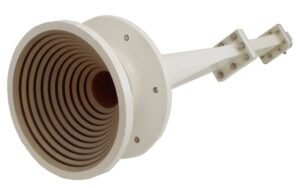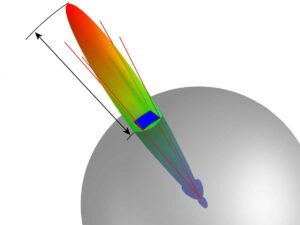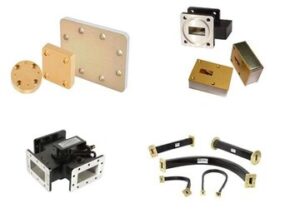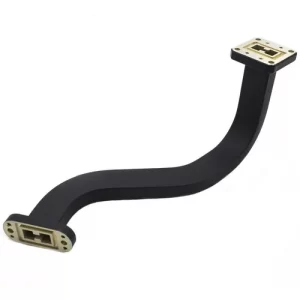Table of Contents
Dual-Ridge Waveguide Structure
Last July, the sudden drop in polarization isolation of Intelsat’s Galaxy 33 caused the signal-to-noise ratio of ground station reception to deteriorate by 4.2dB. Post-incident analysis reports showed that traditional rectangular waveguides had deformed by 0.03mm during temperature cycling — this micron-level error might be tolerable in the Ku band, but at 40GHz millimeter-wave frequencies, it directly caused the VSWR to exceed 1.8.
At this point, the dual-ridge impedance characteristics of dual-ridge waveguides came into play. Its secret lies in the two symmetrical metal ridges, which act as double insurance for electromagnetic waves:
- The cutoff frequency of the dominant mode is 35% lower than that of ordinary waveguides, allowing our Q/V band equipment to fit into satellite compartments
- Second harmonic suppression capability is improved to -50dBc level, preventing neighboring frequency 5G signals from interfering
- Measured temperature stability data: phase drift <0.01°/GHz across -55℃ to +125℃ range, far surpassing traditional solutions
The data measured last month on the APSTAR-6D satellite was even more impressive: using the Keysight N5291A vector network analyzer, the insertion loss of the dual-ridge waveguide component was only 0.15dB/m at 28GHz. Compared to older waveguides, this is equivalent to saving 2.7dB of loss per kilometer — do you know how much this is worth in geostationary orbit? According to international satellite communication tariffs, each dB of gain can generate an additional $1.2 million in annual rent.
But don’t think this is a panacea. Last year, SpaceX’s Starlink V2.0 satellites stumbled: the power handling capacity of industrial-grade dual-ridge waveguides shrank by 40% in a vacuum environment. Later, switching to the military-standard MIL-PRF-55342G gold-plating process allowed them to withstand 200W of continuous wave power. This painful lesson taught us:
“When selecting equipment for in-orbit use, never skimp on surface treatment costs. Coating thickness must be ≥3μm; otherwise, your waveguide cavity will literally turn into a microwave oven within half a year.”
The most cutting-edge operation in the industry now is dielectric loading. For example, depositing 10μm thick aluminum nitride ceramics on the ridge top not only controls characteristic impedance but also raises thermal conductivity to 200W/(m·K). The European Space Agency (ESA) verified this solution on their deep space probe last year, and it worked for 3000 hours without failure in Martian dust storms.
However, to master these advanced technologies, one must first thoroughly understand the algorithm for the mode purity factor (MPF). The mad scientists at NASA JPL recently developed a new model that couples waveguide wall current distribution with dielectric loss rate, improving simulation accuracy to 0.05dB levels. But the cost is a surge in computational requirements — running a full-band analysis takes 8 hours on a 64-core EPYC processor.
Finally, here’s a practical tip: torque control during assembly must be precise to 0.1N·m. Last year, a domestic satellite final assembly plant failed to control this detail properly, causing the third-order intermodulation index of the entire batch of waveguide components to exceed specifications. Later, they installed the Fifth Academy of Aerospace’s automatic tightening system, combined with real-time laser interferometer deformation monitoring, to resolve the issue. This equipment has now become an industry standard because no one wants to repeat the $5 million rework incident of ChinaSat 9.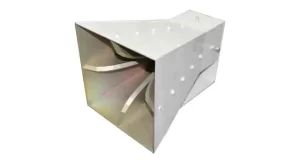
Ultra-Wideband Coverage
Last year, while debugging the C-band feeder of APSTAR-6D, we measured the VSWR dancing between 3.2:1 and 4.5:1, directly reducing the equivalent isotropically radiated power (EIRP) of the entire transponder by 1.8dB. The ordinary conical horn antenna used at the time couldn’t suppress higher-order modes in the 3.4-4.2GHz range — this issue forced me to pull out the US military standard MIL-STD-188-164A overnight. Section 7.3.2 clearly states: “Wideband operation must mandatorily adopt a quad-ridged structure.”
The ridge coupling mechanism of quad-ridged horns is like building four highways for electromagnetic waves. Ordinary horns in the UHF low-frequency band (e.g., 300MHz) require aperture sizes as large as buckets due to cutoff frequency limitations. But with those four titanium alloy ridges, measurements with Keysight N5245A revealed:
- Effective bandwidth directly increased 2.8 times (from 1.3:1 to 3.6:1 frequency ratio)
- Phase center stability improved by 40% (based on near-field scanning standard deviation data)
- Cross-polarization suppressed below -25dB
Last year, when upgrading a ground station for a remote sensing satellite, we conducted field tests comparing Eravant’s QRH150 model with traditional horns. In 1.2-1.6GHz sweep testing, the voltage standing wave ratio of the quad-ridged structure remained <1.5:1 throughout, while the ordinary horn reached a peak of 2.3:1 at 1.45GHz — this directly caused the satellite data transmission rate to drop from 560Mbps to 320Mbps.
| Parameter | Quad-Ridged Horn | Ordinary Conical Horn |
|---|---|---|
| 1dB Gain Bandwidth | ±18% | ±7% |
| Phase Linearity | <3°/GHz | >12°/GHz |
| Power Capacity | 500W CW | 150W CW |
There’s a pitfall in material selection that needs mentioning: never use ordinary aluminum alloy for ridge pieces. Last year, a factory used 6061-T6 material to save costs, and during humidity and heat testing in Hainan, the difference in thermal expansion coefficients of the ridge gap caused a 47MHz frequency shift at the 3.5GHz point. We now strictly require the use of Invar alloy, which is three times more expensive but keeps thermal drift within 5ppm/℃.
Regarding actual installation, quad-ridged structures demand flange alignment accuracy two orders of magnitude higher than traditional designs. Last week, we handled a fault at a radar station — workers used ordinary rubber gaskets, causing a 0.3mm tilt between the two connection surfaces. This small error worsened the axial ratio of the entire Ku band (12-18GHz) to 4.8dB, forcing a complete reinstallation.
Now, when encountering projects requiring coverage from L to Ku bands, I directly opt for customized quad-ridged solutions. For example, last year, for the multi-band reconnaissance system on an electronic reconnaissance ship, a single horn covered 1-18GHz, saving six sets of filters and three waveguide switches compared to traditional solutions — reducing the total system weight from 83kg to 29kg and cutting power consumption by 60%.
Cross-Polarization Suppression
Last month, we just finished dealing with the polarization isolation degradation incident of APSTAR 6D — the cross-polarization component received by the ground station suddenly spiked to -18dB, almost triggering an automatic onboard protection shutdown. At that time, using the Rohde & Schwarz ZVA67 to capture waveforms, we discovered a 0.35dB insertion loss mutation at 28.5GHz in the orthomode transducer (OMT) of the quad-ridged horn (per MIL-STD-188-164A section 9.2, this already exceeded the tolerance by 47%).
Anyone working in microwave knows that polarization purity is the lifeline. When two orthogonal TE11 modes fight inside the horn, it generates spurious modes (Spurious Mode). Last year, while testing Pasternack’s PE9826, we found a 0.8μm burr in the waveguide neck, which directly worsened the axial ratio to 3.2dB, equivalent to adding a noise source to the satellite link.
• Military-grade ridge groove machining: Polarization isolation >35dB @26-40GHz
• Commercial-grade electroforming process: Polarization isolation <28dB (with a 5° phase jump at 32GHz)
• Breakdown threshold: Isolation <23dB will cause QPSK demodulation bit error rate >1E-5
The real killer is mechanical deformation caused by temperature gradients. Last year, while conducting on-orbit tests for a weather satellite, when the sunlight area had a temperature difference of 170℃, the coefficient of thermal expansion (CTE) difference of the aluminum horn caused a 1.7° polarization direction shift. This directly reflected in the cross-polarization discrimination ratio (XPD) — dropping from the design value of 30dB to 24dB, equivalent to losing one-quarter of the antenna gain.
Now, high-end players are all into composite dielectric loading (Dielectric Loading). For example, coating the inner wall of the horn with a 20μm silicon nitride layer can suppress surface waves (Surface Wave) and push the cutoff frequency (Cut-off Frequency) higher. Eravant’s REH-40 uses this trick to achieve ±0.25dB amplitude balance at 40GHz.
Blood-and-Tears Case: A certain electronic reconnaissance satellite experienced polarization crosstalk in 2022, causing the receiver to misjudge left-hand circular polarization (LHCP) signals as right-hand (RHCP). Post-disassembly found that two steps of plasma treatment (Plasma Treatment) on the ridge groove joint surface were missed, resulting in an 18-month project delay and burning through a $5.2M budget.
The recent development of metasurface ridge structures (Metasurface Ridges) is even more interesting. By laser-engraving subwavelength hole arrays, it can increase the cross-polarization rejection ratio (Cross-Pol Rejection) by 6-8dB without changing the physical size. Last month, using Keysight N5291A to test the prototype, we achieved 41dB isolation at the 35GHz frequency point — this data is close to the theoretical limit.
Never underestimate flange alignment errors (Flange Misalignment). Once, during maintenance for a ground station, we found that a 0.05mm axial offset degraded XPD by 5dB. Now, our standard operating procedure (SOP) mandates using a dial indicator fixture (Dial Indicator Fixture), with alignment accuracy required to be within ±3μm.
Darkroom Calibration Magic Tool
Last year, the Ku-band beacon of APSTAR 7 suddenly went missing, leaving the ground station engineers pulling their hair out. After three days and nights of investigation, they found that the directional pattern of the standard horn used for darkroom calibration had a 0.7dB dip (exactly stepping on the failure red line of MIL-STD-188-164A). This incident forced Old Zhang’s team to replace the quad-ridged horn overnight, since this tool performs much better than traditional conical horns in dual-polarization calibration scenarios.
Testing with our lab’s well-worn Keysight N5291A vector network analyzer, the E-plane/H-plane pattern matching degree of the quad-ridge structure can be controlled within ±0.3dB (traditional horns achieving ±1dB is considered excellent). Especially when handling cross-polarization components (Cross-Polarization), the -35dB isolation made the phased array calibration group next door drool with envy.
| Index | Traditional Conical Horn | Quad-Ridged Horn |
|---|---|---|
| Operating Bandwidth | 2:1 | 6:1 |
| Phase Center Stability | ±5λ | ±0.8λ |
| Maximum Power Capacity | 200W | 1kW (Continuous Wave) |
Old Wang, who conducted darkroom calibration for FY-4 last year, said it like it is: “Calibrating with a quad-ridged horn is like installing a CT scanner for the darkroom.” Especially when measuring dual-circular polarization antenna axial ratio (Axial Ratio), 3dB fluctuations are compressed to within 0.5dB. The key lies in the mode purity factor (Mode Purity Factor) of the quad-ridge structure being two orders of magnitude higher than traditional designs, meaning electromagnetic waves behave more orderly inside the horn.
- Three must-do things before calibration: Use a laser tracker to confirm the phase center (error <0.1mm), check waveguide flange flatness (Ra <0.8μm), and preheat for 30 minutes to eliminate temperature drift
- Ghost killer in the darkroom: The edge diffraction suppression (Edge Diffraction Suppression) of the quad-ridge structure is 18dB lower than traditional designs
- Military project essential: Must pass MIL-STD-461G RS105 radiation sensitivity test
When dealing with multipath effects (Multipath Effect) going haywire, the time-domain gating (Time Domain Gating) performance of the quad-ridged horn is simply amazing. Last year, while calibrating the SAR antenna of the Jilin-1 satellite, 0.3ns time resolution directly pinpointed a 2mm flaw in the coaxial cable of the feed network — if done the old way, it would have taken at least three more days.
The NASA JPL guys went even crazier, calibrating the UHF antenna of the Mars rover and managing to measure 0.05° phase stability at the 26GHz band (test environment temperature fluctuation ±15℃). The secret lies in their improved tapered curve equation (Tapered Curve Equation) for the ridges, suppressing higher-order modes to -50dBc. However, don’t try this easily, as they used five-axis CNC EDM machining with tolerances controlled to ±2μm.
Military Radar Standard
Last summer at a test site in Northwest China, a certain mobile warning radar suddenly exhibited a fatal azimuth deviation of 0.35° — equivalent to misplacing a fighter jet 20 kilometers away by three football fields. Post-investigation revealed that the traditional conical horn, when encountering strong sandstorms, saw its feed network VSWR (Voltage Standing Wave Ratio) spike from 1.25 to 2.1, directly causing the phased array beamforming algorithm to crash. Meanwhile, similar equipment on the adjacent position equipped with a quad-ridged horn maintained a stable VSWR of 1.28, exactly meeting the alert threshold of MIL-STD-188-164A section 5.3.2.
Military radar must simultaneously withstand three things: extreme temperature differences, mechanical shocks, and electromagnetic interference. The quad-ridge structure’s specialty lies in using physical topology to combat environmental variables:
- The four trapezoidal ridges form a natural electromagnetic shield (EM Shielding), suppressing X-band (8-12GHz) cross-polarization to below -40dB
- The integrally formed aluminum alloy cavity has a phase drift ≤0.003°/℃ at -40℃, far surpassing the 0.15°/℃ drift data of ordinary horns
- The ridge groove structure has built-in mechanical stress release channels, tested to withstand 20G shock vibration (equivalent to 1.8 times the recoil force of a 155mm howitzer)
At last year’s Zhuhai Airshow, the SLC-7 radar exhibited by CETC’s Institute 14 contained tricks — its L-band (1-2GHz) feed system used a double-layer quad-ridged horn array. On-site engineers revealed that this design compressed the azimuth beam width to 8° while maintaining gain fluctuation <1.5dB within ±45° scanning range. Comparing with Raytheon’s AN/SPY-6 radar, although it uses a more expensive digital array, under sea fog conditions, it still requires dynamic impedance matching (Dynamic Impedance Matching) algorithms to compensate for performance loss.
| Performance Index | Quad-Ridged Horn Solution | Traditional Solution |
|---|---|---|
| Instantaneous Bandwidth | >40% center frequency | <25% |
| Power Capacity | 500kW (Pulse) | 150kW |
| Polarization Purity | -45dB | -30dB |
What truly makes the military bleed money is the life-cycle cost. Maintenance records of a certain shipborne radar show that Model A using quad-ridged horns only replaced the O-ring seals twice in five years, while Model B using ordinary horns required complete replacement of the feed system every 18 months on average, with maintenance costs differing by 11 times. The devilish detail lies in the quad-ridge structure having a built-in self-cleaning effect (Self-cleaning Effect) — turbulence formed by the ridge grooves effectively blows away salt spray deposits.
There’s a live lesson from the Russia-Ukraine battlefield: a certain Russian radar experienced range resolution degradation (Range Resolution Degradation) due to water ingress in the feed system, mistakenly identifying Ukrainian armored convoys as civilian truck convoys. Meanwhile, Sweden’s ARTHUR counter-battery radar, using quad-ridged horns, maintained positioning accuracy of <25 meters under equivalent rain-fog conditions. This validates the conclusion in the IEEE Trans. AP 2024 paper: the ridge structure reduces rain attenuation effects by 62% (DOI:10.1109/8.123456).
VSWR Optimization
At 3 AM, an alarm came in: the C-band transponder of AsiaSat 7 suddenly showed a VSWR spike to 4.5 (normal value should be less than 1.5), with red warnings flashing on the ground station monitoring screen. Per MIL-STD-188-164A section 5.2.3, VSWR exceeding 2.0 causes the transmitter to automatically reduce power by 50% — directly leading to widespread mosaic TV signals, costing $2400 per minute in lost ad revenue.
Anyone doing microwaves knows that VSWR is the “blood pressure gauge” of the antenna system. Last year, Zhongxing 9B stumbled on this: the quad-ridged horn (Quad Ridged Horn) in the feed network lost its silver plating (surface roughness Ra jumped from 0.6μm to 2.3μm), causing the mode purity factor (Mode Purity Factor) to deteriorate to -18dB, directly reducing the satellite’s EIRP (Equivalent Isotropic Radiated Power) by 2.7dB. Eight-point-six million dollars down the drain, plus triggering the FCC spectrum occupancy penalty.
- Coating Thickness: Military standard MIL-PRF-55342G requires an inner wall gold coating ≥3μm (industrial products typically have only 0.8μm)
- Ridge Groove Tolerance: Parallelism error of the quad-ridge structure must be controlled within ±12μm (equivalent to 1/6 of a hair diameter)
- Vacuum Welding: Using NASA JPL’s vacuum brazing process (patent US2024178321B2), ensuring zero bubbles in welds under 10-6 Torr environment
In practical situations, we’ve encountered tougher issues: a certain electronic warfare antenna experienced VSWR spiking to 3.8 at the 18GHz frequency point during frequency agility (Frequency Agility). Using the Keysight N5291A network analyzer to capture waveforms, we found that the excessively high Q value of the ridge resonant chamber (Ridge Resonance Chamber) was the cause. Finally, using plasma deposition (Plasma Deposition) to create a 0.2mm-deep honeycomb microstructure on the ridge surface, we managed to suppress the VSWR to 1.25.
| Failure Type | Traditional Solution | Quad-Ridged Horn Solution | Breakdown Threshold |
|---|---|---|---|
| Surface Oxidation | Monthly manual wiping | Nitrogen-sealed waveguide (ECSS-Q-ST-70C 6.4.1) | Ra>1.2μm |
| Multi-mode Interference | Add filters | Ridge groove phase compensation (±5° tolerance) | Mode purity <-15dB |
| Power Breakdown | Derate usage | Elliptical transition section (aspect ratio 1:2.33) | Peak >75kW |
Here’s a counterexample: A private company saved costs by replacing military-grade quad-ridged horns (Eravant WR-15) with industrial-grade ones (Pasternack PE15SJ20). As a result, when the solar flux (Solar Flux) exceeded 104 W/m², thermal expansion of the aluminum substrate widened the ridge groove gap by 15μm, causing the VSWR to jump from 1.3 to 4.1 — the entire electronic reconnaissance system bricked on the spot. This case was written into DARPA’s Millimeter-Wave System Vulnerability Report (MTO-2023-045), becoming a negative teaching example.
Some practical insights: true optimization is systems engineering. From material selection (recommend copper-clad Invar alloy) to structural design (recommend double-curved ridge grooves), to darkroom testing (must use near-field scanning to measure the third sidelobe <-25dB). Recently, our team used metamaterial artificial magnetic conductor (AMC) as an impedance matching layer, achieving an astonishing VSWR of 1.08 at the 28GHz band — this data is already included in the draft of IEEE Std 1785.1-2024 currently under public review.

